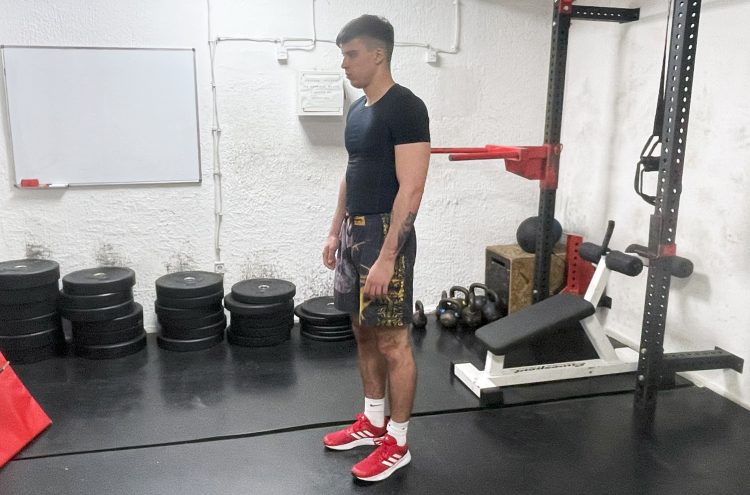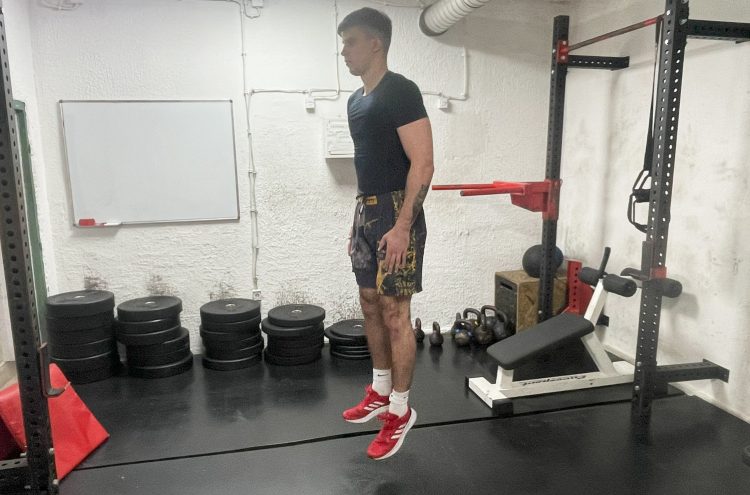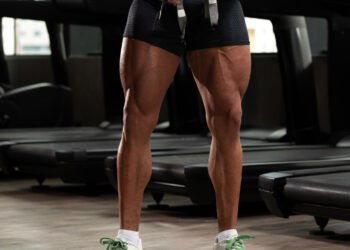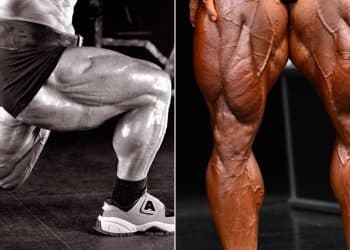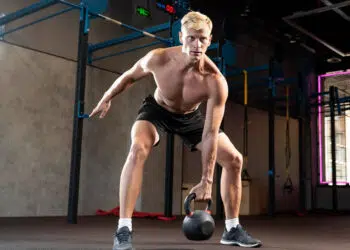Calf jumps, also called pogo jumps, are an effective exercise for improving ankle stiffness, stability, and strength. Athletes and regular gym goers benefit from calf jumps since they can improve your performance while reducing the risk of lower-body injury.
However, most trainers perform this exercise incorrectly. Even though they are called calf jumps, it doesn’t mean you cannot move anything besides your ankle joints. Specific calf jump variations focus on improving the tendons’ force generation capacity by minimizing movement in all joints except the ankles.
However, that is mainly for sport-specific reasons, and there is a certain risk of injury associated with it. That’s why I created a simple-to-follow guide below that teaches the safest and the most effective way to perform calf jumps.
How To Do Calf Jumps
These three steps will help you optimize each phase of calf jumps for maximal performance:
Step One — Assume the Starting Position
Stand with your feet hip-width apart, knees slightly flexed, hips neutral, back straight, and head looking straight ahead. Feel free to experiment with your arm position. You can keep them on the sides or hold them in front of your chest.
Level Up Your Fitness: Join our 💪 strong community in Fitness Volt Newsletter. Get daily inspiration, expert-backed workouts, nutrition tips, the latest in strength sports, and the support you need to reach your goals. Subscribe for free!
Keep your core braced throughout the exercise. This will allow you to transfer energy from your feet to your upper body efficiently.
Pro Tip: To jump higher, swing your arms forward on the takeoff. Start with your arms behind the midline. As you begin the next phase, powerfully swing them forward and upward in front of your chest. This should help you jump higher than usual.
Step Two — Jump
Jump by slightly bending your knees and forcefully extending them with your ankles (plantar flexion). You can bend your knees slightly during the jumping and landing phase, as this will reduce the chance of injuries and make the movement more efficient. Jump towards the ceiling, fully extending your ankles and knees in the air.
Pro Tip: A quick transition between the bottom position and triple extension can lead to higher jumps. This is because you have the help of the stretch-shortening cycle (SSC), which occurs when you quickly stretch your muscles. (1) Since your muscles have an elastic property, they tend to restore the initial length (resting position length), helping you with the concentric contraction.
Step Three — Land
Land on your toes or the balls of your feet first. It is safer to land on the toes, but from an athletic perspective, it is more effective to land directly on the balls of your feet. As you land, slightly bend your knees. Repeat for the recommended reps.
Pro Tip: Minimize the transition time between jumps. Limiting ground contact time maximizes tendon efficiency and the power of the stretch-shortening cycle.
Watch Vanja Vukas perform the calf jumps exercise in the video below:
Ideal Calf Jump Rep Range To Promote Hypertrophy
In a YouTube video, Jeff Nippard, a professional natural bodybuilder and powerlifter, discusses different ways to force your calves to grow with smarter training methods:
“For the calf raise, I think there is merit training across a variety of rep ranges, so anything from six to 20 or more reps. The most recent evidence suggests that both the gastrocnemius and soleus are type 1 dominant, and they may benefit from the use of higher reps, but because we are also taking the ankle through the full range of motion with a biomechanically strong position, I think it could be negligent to exclude any low rep strength work. So I think that splitting where you have at least one heavy day where you work more in the six to 12 rep range and then at least one light day where you work more in the 12 to 20 zone makes the most sense.”
Get Fitter, FasterLevel Up Your Fitness: Join our 💪 strong community in Fitness Volt Newsletter. Get daily inspiration, expert-backed workouts, nutrition tips, the latest in strength sports, and the support you need to reach your goals. Subscribe for free!
Muscles Worked
- The primary muscles working during calf jumps include the gastrocnemius and soleus.
- The secondary muscles include the quads, hamstrings, and core muscles.
Calf Jumps vs. Calf Raises
Here are the main differences between calf jumps and calf raises:
- Explosive strength development: You will develop more explosiveness with calf jumps than with calf raises.
- SSC: The stretch-shortening cycle is much better utilized during calf jumps than during calf raises.
- Tendon energy: You will learn to use the stored energy in your tendons to produce more force when doing calf jumps than when doing calf raises.
- Muscle building aspect: The only advantage calf raises have over calf jumps is their ability to induce muscle hypertrophy, as you can control the rep tempo and time under tension much better.
Benefits of Calf Jumps
Here are the most important calf jump advantages:
Improved Jumping Performance
Calf jumps will improve your jumping performance because you will develop explosive strength and learn how to use the stretch-shortening cycle and tendon energy much more efficiently.
Improved Ankle Stability and Strength
Calf jumps are excellent for improving ankle stability and strength as they strengthen the tendons and ligaments and help build bigger and stronger gastrocnemius and soleus muscles. Plyometric jump training, including calf jumps, is excellent for improving your overall lower-limb stiffness. (2)
Enhanced Athletic Performance
Calf jumps can improve athletic performance. You will feel faster on your feet while also being more reactive and explosive. It can improve your vertical jump performance and develop better and more efficient running mechanics.
Better Calf Development
Calf jumps can help develop the soleus and gastrocnemius muscles. You won’t gain as much muscle as with hypertrophy-focused calf raises, but your muscles will appear more defined.
Calf Jumps Variations and Alternatives
Here are the best calf jump variations and alternatives to consider.
Banded Pogo Jumps (Band-Assisted Pogo Jumps)
Banded pogo jumps are excellent training tools used by athletes. The banded variation helps you jump higher and absorb more force when you land.
Steps:
- Secure two resistance bands to the pull-up bar, shoulder-width apart, with the ends hanging down.
- Hold the upper portion of the resistance bands (closer to the pull-up bar).
- Assume a hip-width stance and slightly bend your knees. Keep your hips neutral, back flat, and eyes looking straight ahead.
- Begin the exercise by jumping and using your hands to pull yourself higher.
- Land softly but immediately reverse the motion and jump again.
- Repeat this jumping motion for the desired reps, but transition between the jumps as fast as possible.
Pro Tip: Ensure the resistance band is securely anchored to offer consistent tension without restricting your natural jumping motion. This will enhance safety and muscle engagement.
Weighted Calf Jumps
They are a more challenging calf jump variation, and an excellent next step once you’ve mastered the form and technique of bodyweight calf jumps.
Steps:
- Hold a kettlebell on each side. Alternatively, wear a weighted vest. A weighted vest distributes the weight evenly across your body and reduces instability compared to using free weights like kettlebells.
- The movement mechanics remain the same as the bodyweight calf jumps.
Pro Tip: Choose a weight that challenges you but still allows you to maintain proper form, maximizing calf muscle activation without sacrificing technique. Keep the free weights close to your body to maintain balance and control during explosive movements.
FAQs
Can calf jumps help improve my running speed and agility?
Calf jumps can definitely help you improve your running speed and agility. They’ll make you more reactive and explosive, dramatically improving your overall jumping coordination.
Are there any risks associated with calf jumps, and how can I perform them safely?
To ensure safety during calf jumps, you must keep your core braced throughout the entire movement. You can potentially damage your patella or twist your ankles if you do calf jumps improperly.
How often should I include calf jumps in my workout routine?
Calf jumps should be performed at least once every two weeks to see progress. Since they are an explosive movement, you should perform them fresh and well-rested to ensure maximal efficacy and performance improvement.
Wrapping Up
Calf jumps are a fantastic tool for improving your overall jumping ability, reactiveness, and ankle stiffness. They are especially good to implement in any type of contrast training, especially the French contrast method, which involves performing three to four exercises in a row without rest.
I love implementing calf jumps as a superset in my workouts. That way, I can improve the time efficiency and variability of my workouts.
In the comments below, let me know your thoughts on calf jumps and your favorite way to implement them in lower-body workout sessions.
References:
- Navarro-Cruz R, Alcazar J, Rodriguez-Lopez C, et al. The Effect of the Stretch-Shortening Cycle in the Force-Velocity Relationship and Its Association With Physical Function in Older Adults With COPD. Front Physiol. 2019;10:316. Published 2019 Mar 26. doi:10.3389/fphys.2019.00316
- Moran J, Liew B, Ramirez-Campillo R, Granacher U, Negra Y, Chaabene H. The effects of plyometric jump training on lower-limb stiffness in healthy individuals: A meta-analytical comparison. J Sport Health Sci. 2023;12(2):236-245. doi:10.1016/j.jshs.2021.05.005
Relevant Articles:
- 34 Best Leg Exercises for Building Muscle and Strength
- Bodybuilding Coach Charles Glass Shares 5 Variation of Exercises to Build Calves

